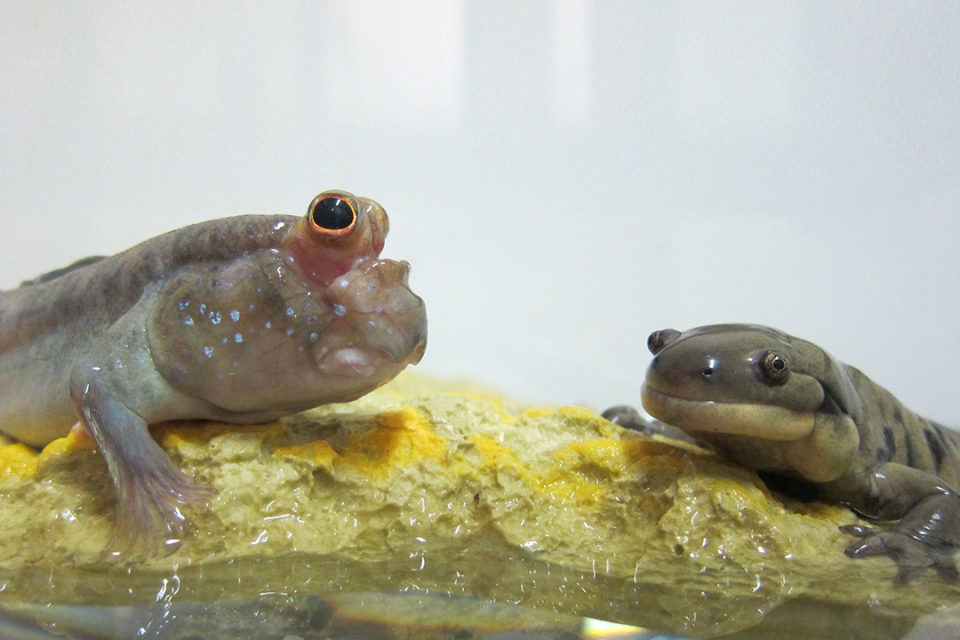By John DiConsiglio
About 400 million years ago, our early ancestors took their first hesitant steps out of the primordial seas on to land.
But did they really step? Or did they crawl? Or wiggle?
Those are some of the questions George Washington University Assistant Professor of Biology Sandy Kawano asks in her Fins and Limbs Lab, a new addition to Science and Engineering Hall that explores the biodiversity of animals through their anatomy and movements.
Using state-of-the-art technology like high-speed digital cameras, 3D modeling and even robots, Dr. Kawano studies how animals move in different environments—their steps, strokes and slithers. Her research is unlocking evolutionary mysteries—such as how our ancestors found their way on to land—that hold hints to modern-day problems from human health to climate change.
“Scientists often act as detectives for the past,” said Dr. Kawano, who joined the biology faculty in the Columbian College of Arts and Sciences in fall 2019. “We’re looking at clues and trying to reconstruct what happened a long time ago.”
Drawing on expertise in biology, engineering and mathematics, Dr. Kawano and her collaborators use robots and computer models to reverse-engineer the movements of the four-legged vertebrates called tetrapods and their fish ancestors. Many of these early tetrapods and tetrapod-like fishes were “nature’s misfits,” she said, with part-aquatic, part-terrestrial bodies. And while no one questions their giant evolutionary leap, how exactly they pulled themselves up on the prehistoric shoreline isn’t settled science.
For decades, the prevailing theory was that tetrapods essentially crawled out of the surf, wiggling their front and hind legs like salamanders. However, “paleontology has undergone a digital revolution and is revealing much more” about their sea-to-land transition, Dr. Kawano said. “We’re now starting to incorporate cutting-edge technology and animation to really get a sense of how these long-extinct fish potentially moved.”
Using these new techniques, Dr. Kawano has drawn on the findings of colleagues who re-analyzed fossils chiseled from frozen rock in Greenland as well as observations of similar modern-day creatures like mudskippers. Their conclusion? “Some of the earliest tetrapods could not have pushed themselves up on land with their hind legs like a salamander,” she said.
In other words, early terrestrial pioneers obviously made it on to land. But how?
“One of the great things about being a scientific researcher is that you always have new mysteries to explore,” Dr. Kawano said. “We are at the tip of the iceberg in understanding how we took those first steps—and what it means to us today.”

A model of an early tetrapod from the Cleveland Museum of Natural History (Photo: Cleveland Museum of Natural History).
Land Rovers
For ancient animals adapted to living in the water, the first moves to land were dangerous undertakings. True, they were leaving behind shark-like predators. But swapping their fins for limbs left them stuck in muddy shores, baking under the unfamiliar sun. “It wasn't paradise,” Dr. Kawano said.
Although their limbs had evolved to the point where they may have walked along the sea floor, “they still were very much aquatic animals—they were very fishy. They had to worry about drying out, they had to worry about gravity. It was not necessarily a quick switch over to a terrestrial life.”
For clues on how they adapted, Dr. Kawano points to the African mudskipper.
A fish that both swims in the water and crawls on the land, it's one of the few living species believed to move in a similar way to those first land vertebrates. Using two front appendages, which resemble a cross between fins and limbs, mudskippers don’t walk or waddle as much as they drag themselves across tidal floors and rocky beaches—not with the boost of their back legs but by pulling their bodies with their front limbs.
Dr. Kawano, a self-described “fish person,” has explored ancient anatomy and movement with a team of physicists and engineers from the Georgia Institute of Technology, Carnegie Mellon University and Clemson University. “I represented the biologists in the group,” she said. Together, the team first built a robot to replicate the mudskipper movements—a “muddy bot,” as they dubbed it. She also uses high-speed video to take slow motion recordings of live mudskippers and salamanders and fine tune ideas about the motion of the fish and their prehistoric counterparts.
The results of her research will not only solve an evolutionary mystery. The riddle of the tetrapod steps has implications for determining how animals overcome shifting environments, including landscapes altered by climate change. And her focus on anatomy and movement may offer insights to the human body’s ailments from knee joint pain to back aches.
“The really exciting part of science is that the more new evidence we find, the more new questions we open up,” Dr. Kawano said. “Even though we are working with these extinct animals that are really, really old, they're still bringing up new questions about what we can understand about and learn from our past.”




